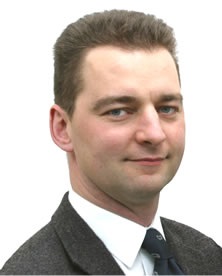
Please can you give a brief introduction to homologous recombination?
Homologous recombination is a technology that enables the targeted insertion of nucleotide fragments into the genome of a cell.
It is called ‘homologous’ because it uses a sequence that is a homologue to the sequence being targeted in a gene, so that the sequence is recognized.
It is basically a technology that enables you to target the specific point in a gene that you are interested in using a homology between the shuttle vector and the locus you are targeting.
What research applications can homologous recombination technology be used for in genetically modified rodents?
The main application today is creating humanized, in vivo models for testing drug candidates. Human genes are inserted in place of the murine genes and therefore the human protein is expressed instead of the mouse protein, providing a natural target for the compound being tested.
The researchers benefit from being able to test the drug in a physiologically complex mammal but the protein the drug interacts with is exactly the same as the one that would be found in a human. The model is therefore a much more relevant, creditable and predictable model for in vivo testing of compound efficacy and toxicity, for example.
Cellectis recently announced an exclusive partnership with genOway. Please can you tell us more about this agreement?
The technology has been developed by the Pasteur Institute in Paris, which patented the technology. The deal we just signed with Cellectis is that genOway will be the exclusive licensee for any relevant application of the technology for pharmaceutical research and development.
For Cellectis, this means the technology is made available to companies by a leader in the field of mouse models so that its uses can be optimised and valorized.
GenOway knows the market, the customers, the end users and all the rules regarding rights to use the technology, which is at the core of our business.
Scientists may need to use a model that has been developed elsewhere but to do so they need to have the freedom to operate it and that’s something we can provide them with.
Any use of the technology in the biopharmaceutical research field will go through genOway and our job is to put the technology out there and make sure everybody is using it as much as possible.
You have been quoted as saying “this complete and exclusive agreement is the solution the market has been waiting for”. Please can you explain the limitations of the current market and how this partnership will be of benefit?
All the models currently available are made using a lot of different technologies which can sometimes make it very difficult for the user to get the model they need as well as the freedom to operate it and to do their research.
What we have done in making this agreement is paved the way for making all that major technology in the industry available.
Almost all the key technologies in the portfolio will be available so we can provide our customers with the freedom to operate any kind of model.
For example, you should be able to think of a model used in one lab, go to genOway, and come away with the model you need as well as the freedom to operate it.
How will this technology enable genOway to provide rodent models that exactly fit researchers’ needs? Will any development be needed on these models?
Researchers need a model for in vivo studies, a model that really answers their questions. At the moment, to completely test a drug can take several years. The researchers hope they can get what they need from the animal models but new models are often required over and over again which can take a significant investment.
Researchers would really like to be able to say that this long process, their program, is very important and worth investing in and that it will have consequences that will impact over three, four or five years.
When you are looking at a five year program, you question the value of the model, how it has been designed, how it fits with the program, how it fits with your scientific hypothesis and the way you are going to use the model.
The value of the model is therefore essential in the outcome of the program and it is very important to be able to provide the right model, one that fits in with that specific program, that specific company and at that specific time.
genOway’s aim is to have a complete portfolio of all the technologies available so that the only thing that can limit how we create a model for the customer is the limit of what is technologically possible today.
Now, we have the complete platform from which to create any kind of models in the mouse. We have all the solutions so that we can create the exact model a customer needs as well as providing them with the freedom to operate.
What do you think the future holds for genetically modified animal models?
The key thing is to see the strengths and weaknesses of the animal model. Why are scientists choosing animal models rather than cells or in silico studies? They are using them because the complexity of some physiological responses is such that there is no in vitro cell system that can mimic them.
Of course, the in vitro solutions are improving and we can now do things in vitro that we were not able to do 10 years ago but people are still using animal models because of the complexity of the human physiology.
However, the drawbacks of using the animals is that the model is always far from human. So, you get the complexity of the mammals but you lose a very important parameter which is species specificity.
If you are targeting a receptor in a human but you test the compound in a mouse, the receptor protein itself will be different. It might not be a big or significant difference, but on the other hand, it may be a very significant difference. The genetically modified animal models will help research to move forward by narrowing this gap, this species difference.
We want to make the models as human as possible. We need to make sure that the protein of interest is the human protein and that in the mouse it is expressed on the same cells as it would be in a human.
Using the genetically modified animal to reduce the difference between the human and the mouse will hopefully allow for better adjusting, more predictable, more reliable data and better answers in terms of thinking about what will happen during human drug testing later on in the process.
What are your plans for the future?
We want to carry on investing in the platform so that we become the main point of reference as a provider of high value models.
We want to build new types of models and new technologies that help us to make more sophisticated and complex models for mimicking clinical situations in humans even more closely.
We want to provide pharma companies and biotech companies with the best models so they can focus their research, move forwards quickly and reduce drug development deadlines so that people can benefit as soon as possible.
Where can readers find more information?
http://www.genoway.com/
About Alexandre Fraichard
 Alexandre is a French national. He earned his Ph.D. at the Ecole Normale Supérieure de Lyon in Molecular and Cellular Biology in 1997. He then worked for five years at the ENS where he produced the first animal model of hypothyroidism, and co-founded the Transgenetic Center.
Alexandre is a French national. He earned his Ph.D. at the Ecole Normale Supérieure de Lyon in Molecular and Cellular Biology in 1997. He then worked for five years at the ENS where he produced the first animal model of hypothyroidism, and co-founded the Transgenetic Center.
In 1998 Alexandre began an MBA at the HEC business school (Paris, France) and he co-founded genOway in 1999. He is the CEO of the company.
Other major achievements include the first cloned rat (published in 2003), the genOway IPO in 2007, and multimillion dollar deals with pharmaceutical companies as off 2009, plus strategic alliances in 2012 and 2013.